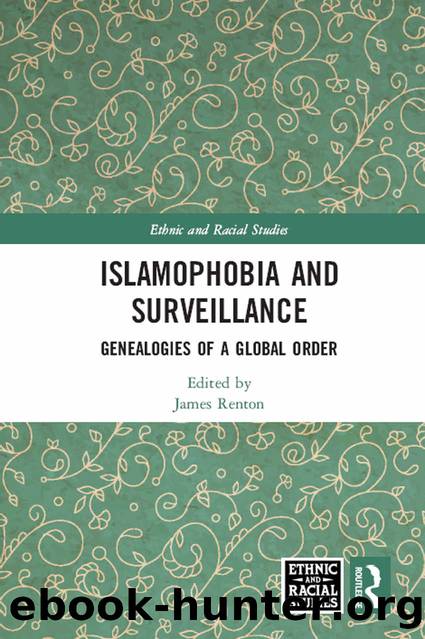Islamophobia and Surveillance (Ethnic and Racial Studies) by James Renton

Author:James Renton [Renton, James]
Language: eng
Format: epub
Publisher: Taylor and Francis
Published: 2020-06-29T07:00:00+00:00
A dominant prejudice against Muslims in Europe is that there is a bond between âall Muslimsâ (Kundnani 2014). When someone, labelled by the media as a Muslim, commits a misdemeanour â it is seen as seems normal to turn to the nearest mosque and ask the ârepresentativeâ to denounce the perpetrator. All differences â linguistic, ethnic, religious, and gender â disappear to be replaced by prejudicial perceptions much like the false homogenizing perceptions of Jews created by the practice of shtadlanut. This tendency to homogenize and reduce the other is, according to Said, part and parcel of the common roots of antisemitism and orientalism, and more specifically the many forms of Islamophobia that are to be seen across Europe and in the media. Likewise Said, influenced by both Arendt and Foucault, notes how Muslims have internalized this frame, an internalization which is normalized and further leads to internal divisions and depoliticization (Said 1979). This homogenization is thus part of the discursive association of Jews and Muslims/Arabs in the European social imaginary, an association that is implicitly propagated by such management practices as shtadlanut.
Many contemporary scholars of Islam in Europe have begun to investigate a new rhetoric of âgoodâ and âbadâ Muslims (Hajjat 2010; Mamdani 2002) as well as tighter control and regulation of Muslim Councils (Amir-Moazami 2011; Kundnani 2014). What is clear from our analysis of the practice of shtadlanut is how these two effects are related. Much like the discussions in the past about Jews having divided loyalties, Muslims in Europe are being essentialized as âa single block and homogeneous entityâ (Ajala 2014, 131) who are equally divided in their loyalties. According to Lacey, âthe orientalist discourse has been further adapted, particularly since 9/11, where both politicians and academics introduce provisos into their discourse, creating a dichotomy between âgoodâ and âbadâ Muslimsâ (Lacey 2014, 97). The former are âmoderateâ Muslims who like Arendtâs parvenus wish to be âacceptedâ; the latter are the âfundamentalistsâ, âradicalsâ or âterroristsâ because they refuse to conform to the demands of authority. These good Muslims, like the good Jews of the nineteenth and twentieth centuries, are âintegratedâ or âassimilatedâ individuals, secularized liberals who have âbecomeâ law-abiding Muslims (not law-abiding citizens). The âbad Muslimsâ cannot be trusted, are all potential terrorists and disloyal to the state. Most recently with the rise of ISIS and the terror attacks, all Sunnis have been unjustly framed as âbadâ Muslims and are under suspicion solely because of their origins.
The second noted change concerns the creation and regulation of Muslim councils both at the national and trans-national level. As this article has demonstrated, there is a shared genealogy between present Muslim councils and those, both past and present, used to manage Jewish minorities in European nation-states. As each nation has its own particular history and position on stateâchurch relations, there are undoubtedly many differences. One important difference is the fact that Jews were often, though not always, stateless minorities. By contrast, Muslims in Europe today are not stateless (some even have dual citizenship).
Download
This site does not store any files on its server. We only index and link to content provided by other sites. Please contact the content providers to delete copyright contents if any and email us, we'll remove relevant links or contents immediately.
Kathy Andrews Collection by Kathy Andrews(11340)
The remains of the day by Kazuo Ishiguro(8410)
Paper Towns by Green John(4807)
Spare by Prince Harry The Duke of Sussex(4800)
Industrial Automation from Scratch: A hands-on guide to using sensors, actuators, PLCs, HMIs, and SCADA to automate industrial processes by Olushola Akande(4625)
The Body: A Guide for Occupants by Bill Bryson(4590)
Be in a Treehouse by Pete Nelson(3654)
Machine Learning at Scale with H2O by Gregory Keys | David Whiting(3653)
Harry Potter and the Goblet Of Fire by J.K. Rowling(3615)
Never by Ken Follett(3545)
Goodbye Paradise(3458)
The Remains of the Day by Kazuo Ishiguro(3146)
Into Thin Air by Jon Krakauer(3132)
The Cellar by Natasha Preston(3078)
The Genius of Japanese Carpentry by Azby Brown(3041)
Fairy Tale by Stephen King(2961)
120 Days of Sodom by Marquis de Sade(2943)
Drawing Shortcuts: Developing Quick Drawing Skills Using Today's Technology by Leggitt Jim(2943)
The Man Who Died Twice by Richard Osman(2818)
